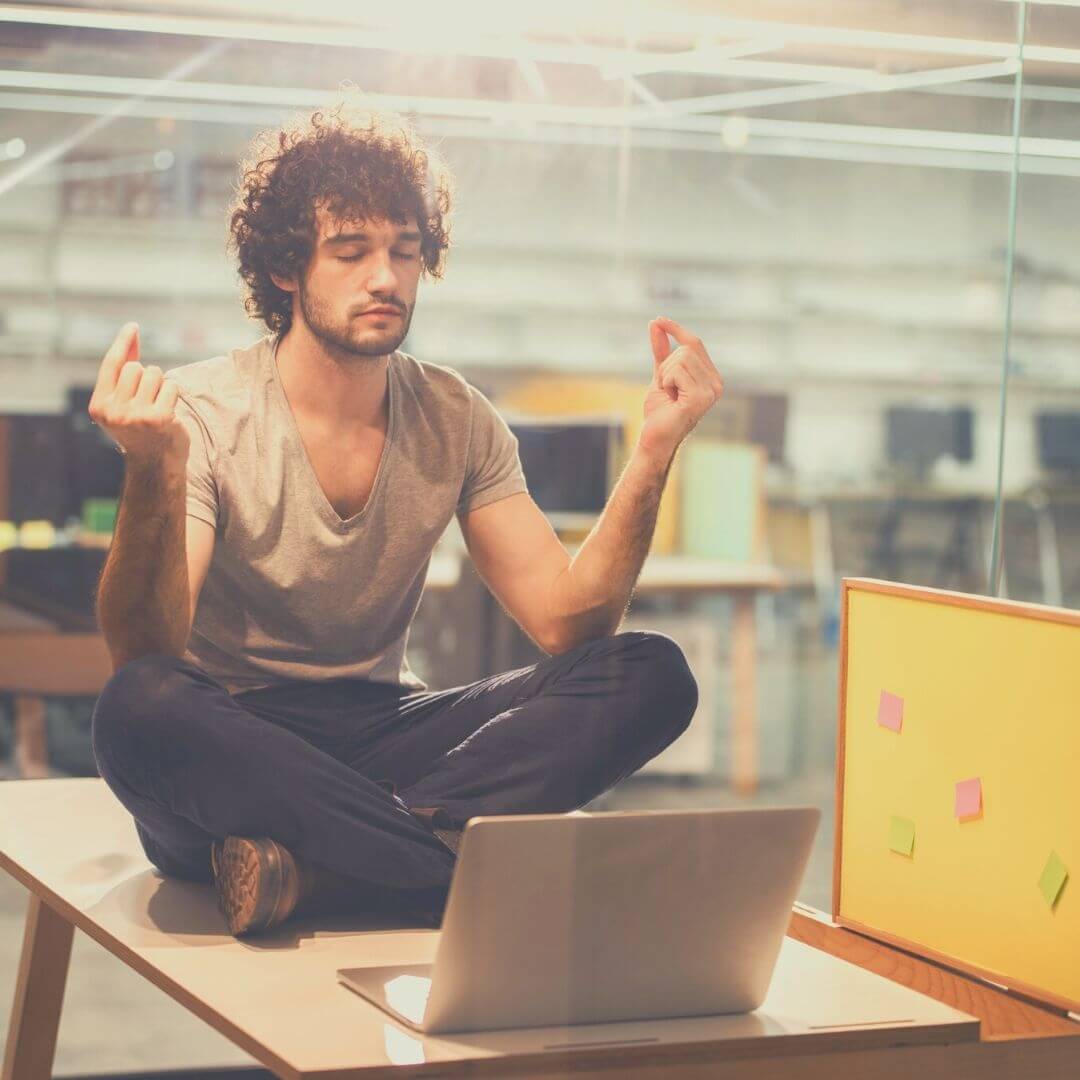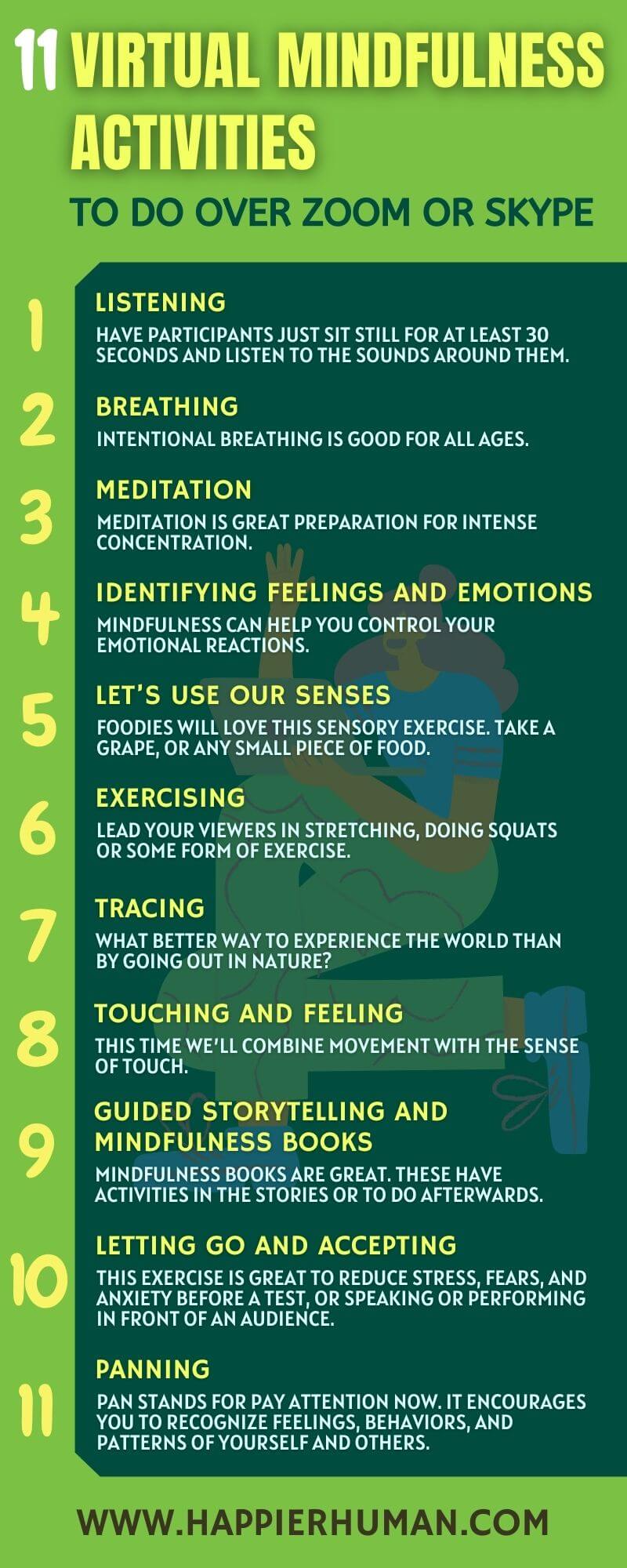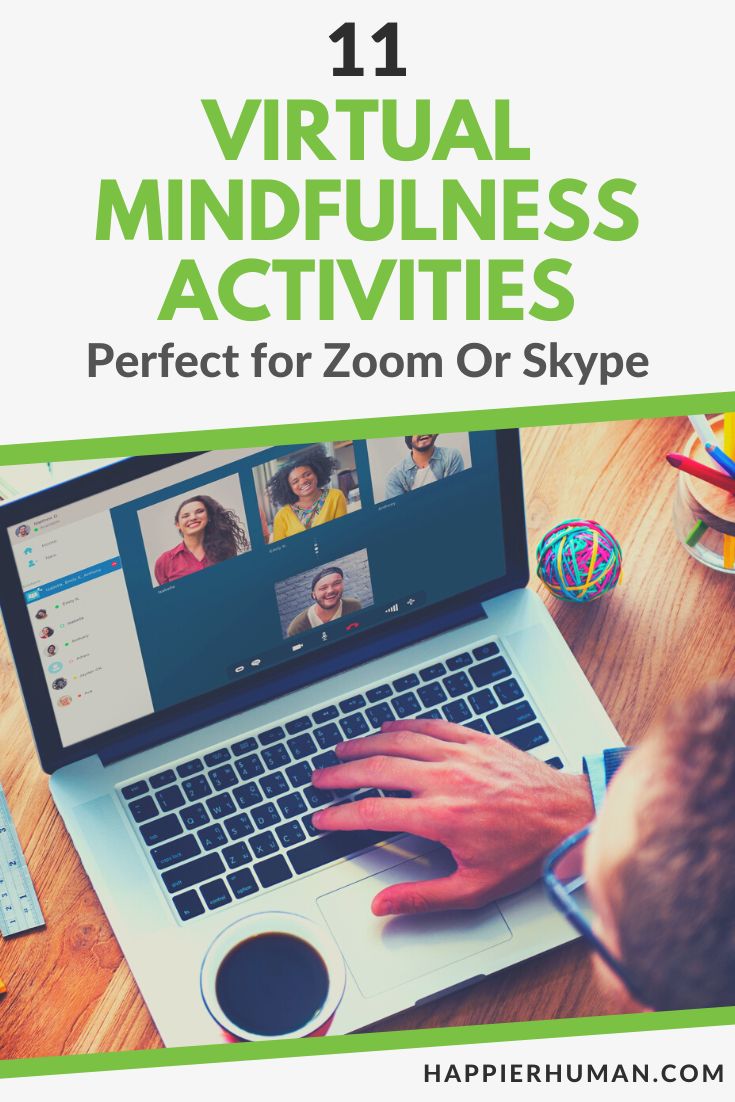Learning virtually and working remotely have benefits. But they can also cause individuals to feel disconnected and struggle with a lack of productivity, due to distractions at home.
As teachers and managers, we have the challenges of keeping individuals mentally present, engaged, and accountable. If you're like me, you also want people to feel connected.
In this post, I will define mindfulness, discuss its benefits and suggest virtual mindfulness activities that can address these challenges.
What is Mindfulness?
Mindfulness is about living in the present moment. It means being aware of how you are feeling and accepting it without judgement. When you practice mindfulness, you experience the world as it's happening. It’s intentional awareness.
You can practice mindfulness by using your five senses to experience the here and now.
The video below shares 7 morning routine ideas that can help you become more mindful on a daily basis.
Challenges of Virtual Learning and Working
Adults and students of all ages have similar challenges when working or schooling from home. As we sit looking at a computer screen, it can be a struggle to feel a true sense of connection.
School children are cut off from the social benefits of physically going to school, like a sense of belonging or the shared purpose they can find in extra-curricular activities. Whereas adults miss out on the conversations at the water cooler that can create relationships with co-workers… and a sense of bonding.
Adults and students of all ages miss out on the built-in social opportunities lunch breaks provide for people to break bread with one another, share stories and laugh together.
Accountability is also a challenge with virtual communication. Children, especially younger ones, need more guidance and prompting to stay on task. I’ve seen this first hand with my kindergarten and 1st grade children.
But even older children and big kids (known as adults), can struggle with staying focused… with so many distractions and no teachers or co-workers physically present.
A cell phone and the internet will temp us with material unrelated to what we’re supposed to be fixed on. Then there's the frustration of not being able to access lessons, virtual classrooms, meetings or other work due to internet problems.
Since mindfulness brings you into the present and makes you intentionally aware of your surroundings, it helps you focus on the task at hand in spite of distractions. It gives you stress and anxiety reduction strategies to help you stay calm when the internet won't do its part and allow you to access necessary work.
Introducing students and employees to virtual mindfulness activities gives them the skills to practice on their own and apply to other situations in their lives. Doing exercises as a group creates a sense of connection.
Once learned, staff and students can do them ahead of time to help stay fully present for the upcoming call. Or, they can use mindfulness during a class session or meeting to get back on task after being distracted or feeling overwhelmed.
Benefits of Mindfulness
Mindfulness is the new buzzword. But like meditation, it's been around for a long time. Mindfulness can be applied to every part of life.
Often, when we are anxious, stressed, or even depressed, it is because we are reliving or thinking about the past, or worried about the future. It's hard to ruminate about unchangeable past events, or worry about a future that we only have so much control over anyway, when you're in the here and now.
Mindfulness improves focus, increases awareness of your feelings, and helps you regulate emotions and better manage how you respond to others and uncomfortable situations. It can reduce stress and anxiety levels.
These cognitive and emotional improvements can help you be better prepared for tests, public speaking, or other distressful events. And they can improve your performance.
Mindfulness gives you coping skills you can use to relax or stop unwanted, intrusive thoughts or worries.
It also gives you conflict management skills. The next time you find yourself at odds with someone, agree that you will stop and practice a mindfulness activity to calm down, regroup, and approach the situation in a less aggressive and more thoughtful way.
You may, first, have to model some mindfulness strategies. What better way to manage your own internal processes and external manifestations of them than to model for someone else how to do it — right at the beginning of a conflict?
Virtual mindfulness activities, even when done in-person, transcend socioeconomic status. They're free. No one has to feel left out because they can't afford it. No equipment or apps are required. And they can be adapted to fit the situation or participant demographics.
Whether working from home is better or worse, most will have to return to the traditional, physical work or school location one day. Practicing mindfulness now can help employees and students focus and stay present when that day arrives.
Although I recommend these as virtual mindfulness exercises, they can be done remotely or in person.
11 Virtual Mindfulness Activities to Do Over Zoom or Skype
Believe it or not, many of the same mindful activities can be done by both adults and children. Where some are too simple or too mature, they can be modified.
1. Listening
This activity can take many forms. Have participants just sit still for at least 30 seconds and listen to the sounds around them.
You can make it more of an active listening exercise. Give the first person a topic to talk about for approximately 1-2 minutes, then have the next person summarize and add some thoughts. Follow this pattern until you get to the last person.

You can also start off a meeting or lesson, or intervene in a conflict, by telling individuals to listen to the person speaking without judgment. This combines active listening and the mindfulness tenet of acceptance without judgment.
The person must listen without emotionally reacting or thinking of a response, forcing them to be fully present. If there's a conflict, it forces them to really hear or consider the other's feelings and point of view.
2. Breathing
Belly breathing is great for younger children. Students relax, and place one hand on their stomach. They feel their bellies move, as they breathe deeply, inhaling for five seconds and exhaling for three. Students repeat this a few times.
Intentional breathing is good for all ages. Older children and adults can inhale, pause, exhale, and rest, doing each for four seconds.
3. Meditation
It may take a few times for children to get the hang of this. Ask them to sit in a comfortable position and think about how they feel. Have them inhale deeply and exhale, thinking of their stomach as a balloon inflating and deflating.
This is similar to belly breathing, except there's no counting as a distraction. The focus is completely on breathing.
Even adults may need some time to warm up to meditation. Using a guide can make it easier and more relaxing. Here's a list of some meditation and mindful podcasts for all ages that you and participants can use.
Meditation is great preparation for intense concentration.
4. Identifying Feelings and Emotions
Mindfulness can help you control your emotional reactions. But first, of course, you must be aware of your emotions.
Children can draw “smiley” faces or their own “home-made” emoticons for what they're feeling. They can draw angry or sad faces.
You can also introduce them to other emotions they may not be as likely to identify, like disappointment, frustration, and hurt.
For older children and adults, you can have them share how they're feeling at the moment, especially at the beginning or end of the lesson or meeting.
Providing a feelings chart can be helpful. Like younger children, older people can have difficulty recognizing feelings like hurt or frustration versus anger.
This PositivePsychology.com article has a link to a more complicated feelings identification exercise for adults or mature students. The article also includes a comprehensive introduction to mindfulness, with multiple definitions, exercises, and research-based benefits. Scroll to the bottom of the article to access the PDF.
5. Let's Use Our Senses
Foodies will love this sensory exercise. Take a grape, or any small piece of food.
What does it smell like? What color is it?

Eat it purposefully. Feel its texture. Did the juice explode or kind of seep out? If seeded, did you catch the hardness of the seed on your tongue or was it the crunch in between your teeth that made you spit it out?
When do you ever experience food like this? You are certainly, without a doubt, in the here and now.
6. Exercising
Lead your viewers in stretching, doing squats or some form of exercise. Give them a break from sitting by inviting them to walk into another room and come back.
Have them pay attention to how each movement feels. It's not the process but the sensory details that are most important.
What colors and objects do they see while walking? Did the sounds change from one room to another?
7. Tracing
What better way to experience the world than by going out in nature? Although we're tied to our devices for Zoom or Skype, the beauty is that they're mobile.
Let's take our virtual mindfulness activities outdoors. With your laptop or phone in tow, pick up a leaf.
This can help you slow your thoughts and breathing. With your eyes, trace the leaf slowly. As you go up, inhale. As your eyes go down, exhale.
If no leaves are available or going outside is not an option, participants can use their hand. Ask them to open one hand widely as if tracing it on a piece of paper. Trace each finger with the other hand, inhaling and exhaling the same as with the leaf.
If this exercise seems too child-like, just relax and let your inner child embrace it — without judgement.
8. Touching and Feeling
Let's go for another walk. This time we'll combine movement with the sense of touch.
Bare feet, outdoors or inside, what does the ground feel like? This is great to do on sand or grass, but it can work on carpeted or hard floors, too.
If participants must be indoors, they can walk from one surface to another, maybe from a tiled floor to a piece of carpet. Is it smushy, soft, cold, hard, rough, gritty?
9. Guided Storytelling and Mindfulness Books
Now we're combining the school lesson with mindfulness. Have students get in a comfortable position and close their eyes. You can introduce a science lesson by having them imagine what their surroundings would look, smell, and sound like if walking in a field of flowers, a garden, or zoo.
For younger children, mindfulness books are great. These have activities in the stories or to do afterwards.
In the workplace, a manager or co-worker could introduce a new product, work process, or client as employees close their eyes and imagine details and benefits.
Details may be what the product may taste like, the sounds that may be made while carrying out the new process, or to lighten the mood, what the new client may smell or dress like.

10. Letting Go and Accepting
By now, you've probably noticed that many of these virtual mindfulness activities are done in combination.
This exercise is great to reduce stress, fears, and anxiety before a test, or speaking or performing in front of an audience.
Have participants sit quietly, and while breathing gently, identify how they're feeling, accepting it without judgment. It's how they're feeling, not who they are. Don't focus on negative thoughts, but on how each part of the body feels as it relaxes and releases tension.
For children, you may want to guide them, softly instructing them to let their toes relax, then their feet. Invite them to feel their legs loosen up, and follow this pattern until you've covered their entire body.
11. PANning
Identifying emotions is taken to another level with this activity. PANning is good to help everyone feel included and identify when individuals may feel marginalized, offended, and possibly even triggered by something said or done.
PAN stands for pay attention now. It encourages you to recognize feelings, behaviors, and patterns of yourself and others.
When a difficult topic is being discussed, you notice students are becoming disengaged, or something inappropriate or disruptive has been said or done during the Zoom session, you can “pan” the audience and share what you've noticed. Invite others to share their feelings, too, while everyone listens and shares without judgement.
While the behavior or what was said may have to be addressed (with judgement) at some point (especially when it comes to managing student behavior), the feelings, or visceral reaction to it, should not.
Final Thoughts on Virtual Mindfulness Activities
The benefits of practicing mindfulness — improved focus, increased emotional awareness, and stress reduction — promote engagement and enhanced productivity.
Doing virtual mindfulness activities together over Zoom or Skye can give students and employees the positive mental health benefits of feeling connected to others and supported. But you, or they, will never reap the advantages if you don’t like it enough to do it.
In case the activities in this article don’t float your boat, here are more for children of all ages and adults. They can be done in person, or adapted to Zoom.
And if you're looking for more suggestions, be sure to check out these articles:
- 27 Mindfulness Activities for Seniors & the Elderly
- 13 Mindfulness Group Activities & Exercises
- 7 5-Minute Mindfulness Activities to Quickly Calm Yourself
Finally, if you want a simple way to reduce your stress and anxiety, then try writing these 35 mindfulness journaling prompts to live more in the present moment.


